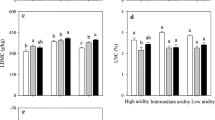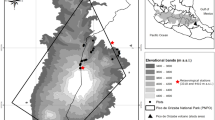Abstract
Accumulating evidence has shown that the scaling exponent (α) of the aboveground biomass-density relationship is not a constant value. Debate continues over what determines the variation in α. By measuring foliar stable carbon isotope, plant morphological traits and α along an aridity gradient from eastern to western China, we confirmed that the variation in α was accounted for by changes in plant morphological traits which are adaptive strategies for enhancing water use efficiency during drought stress. This information can be crucial for understanding and predicting community and ecosystem processes.
Similar content being viewed by others
References
Damuth, J.D., Common rules for animals and plants, Nature, 1998, vol. 395, p. 115.
Enquist, B.J., et al., Allometric scaling of plant energetics and population density, Nature, 1998, vol. 395, p. 163.
Dodds, P.S., Rothman, D.H., and Weitz, J.S., Reexamination of the “3/4-law” of metabolism, J. Theor. Biol., 2000, vol. 209(1), pp. 9–27.
Darveau, C.A., et al., Allometric cascade as a unifying principle of body mass effects on metabolism, Nature, 2002, vol. 417, p. 166.
Kozlowski, J. and Konarzewski, M., Is West, Brown and Enquist’s model of allometric scaling mathematically correct and biologically relevant? Funct. Ecol., 2004, vol. 18, p. 283.
Brown, J.H., et al., Yes, West, Brown and Enquist’s model of allometric scaling is both mathematically correct and biologically relevant, Funct. Ecol., 2005, vol. 19, p. 735.
Morris, E.C., Self-thinning lines differ with fertility level, Ecol. Res., 2002, vol. 17, p. 17.
Deng, J.M., et al., Plant mass-density relationship along a moisture gradient in north-west China, J. Ecol., 2006, vol. 94, p. 953.
Chu, C.J., et al., Balance between facilitation and resource competition determines biomass-density relationships in plant populations, Ecol. Lett., 2008, vol. 11, p. 1189.
Pretzsch, H., Species-specific allometric scaling under self-thinning: evidence from long-term plots in forest stands, Oecologia, 2006, vol. 146, p. 572.
Clark, J.S., Integration of ecological levels: individual plant growth, population mortality and ecosystem processes, J. Ecol., 1990, vol. 78, p. 275.
Dai, X.F., et al., Plant height-crown radius and canopy coverage-density relationships determine above-ground biomass-density relationship in stressful environments, Biol. Lett., 2009, vol. 5, p. 571.
Bai, Y.Y., et al., Variation in root: shoot ratios induced the differences between above and belowground massdensity relationships along an aridity gradient, Acta Oecol., Oecol. Plant., 2010, vol. 36, p. 393.
Zhang, H., et al., Sensitivity of response to abscisic acid affects the power of self-thinning in Arabidopsis thaliana, Bot. Bull. Acad. Sin., 2005, vol. 46, p. 347.
Zhang, W.P., et al., The difference between above-and below-ground self-thinning lines in forest communities, Ecol. Res., 2011, vol. 26, p. 819.
Zhang, J., et al., Carbon storage by ecological service forests in Zhejiang Province, subtropical China, For. Ecol. Manage., 2007, vol. 245, p. 64.
Liu, Y.C., et al., Studies on biomass and net production of Quercus acutidentata forest in Baotianman Nature Reserve, Acta Ecol. Sin., 2001, vol. 21, p. 1451.
Cheng, D.L. and Niklas, K.J., Above-and below-ground biomass relationships across 1534 forested communities, Ann. Bot. (Oxford, U. K.), 2007, vol. 99, p. 95.
Zheng, S.X. and Shangguan, Z.P., Spatial patterns of foliar stable carbon isotope compositions of C3 plant species in the Loess Plateau of China, Ecol. Res., 2007, vol. 22, p. 342.
Gedroc, J.J., et al., Plasticity in root/shoot partitioning: optimal, ontogenetic or both? Funct. Ecol., 1996, vol. 10, p. 44.
Schenk, H.J. and Jackson, R.B., Rooting depths, lateral root spreads and below-ground/above-ground allometries of plants in water-limited ecosystems, J. Ecol., 2002, vol. 90, p. 480.
King, D.A., The adaptive significance of tree height, Am. Nat., 1990, vol. 135, p. 809.
Yin, C.Y., et al., Morphological and physiological responses of two contrasting Poplar species to drought stress and exogenous abscisic acid application, Plant Sci., 2004, vol. 167, p. 1091.
Author information
Authors and Affiliations
Corresponding author
Additional information
The article is published in the original.
Rights and permissions
About this article
Cite this article
Wang, N., Gao, J., Xu, SS. et al. Biomass-density relationship varies with water use efficiency across an aridity gradient. Contemp. Probl. Ecol. 6, 370–373 (2013). https://doi.org/10.1134/S1995425513040069
Published:
Issue Date:
DOI: https://doi.org/10.1134/S1995425513040069




